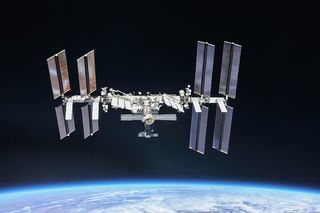
The International Space Station just dodged a fast-moving hunk of orbiting junk.
Controllers maneuvered the station away from a potential collision with a piece of debris today (Sept. 22) at 5:19 p.m. EDT (2119 GMT). They did so by firing the thrusters on a Russian Progress cargo spacecraft that's docked to the orbiting lab's Zvezda service module, NASA officials said in an update today.
The three astronauts currently living aboard the station — NASA's Chris Cassidy and cosmonauts Anatoli Ivanishin and Ivan Vagner — sheltered in the station's Russian segment during the maneuver to be closer to their Soyuz spacecraft, the NASA update stated.
This was done "out of an abundance of caution," the update said. "At no time was the crew in any danger."
Related: 7 wild ways to clean up space junk
Maneuver Burn complete. The astronauts are coming out of safe haven.September 22, 2020
The trio's stay near the Soyuz, which will bring them back down to Earth next month, was quite brief.
"Maneuver Burn complete. The astronauts are coming out of safe haven," NASA Administrator Jim Bridenstine tweeted at 5:25 p.m. EDT (2125 GMT) today, just six minutes after the Progress thruster firing.
Get the Space.com Newsletter
Breaking space news, the latest updates on rocket launches, skywatching events and more!
Space junk is a growing problem in Earth orbit. Nearly 129 million pieces of debris are whizzing around our planet at the moment, about 34,000 of which are more than 4 inches (10 centimeters) wide, according to estimates by the European Space Agency.
At the International Space Station's altitude, roughly 250 miles (400 kilometers) up, material zooms around Earth at about 17,500 mph (28,200 kph) — so fast that a collision with even a tiny shard of debris could do serious damage to the orbiting lab.
Hence today's evasive action. The 150-second-long Progress burn boosted the station above the trajectory of the unknown piece of debris, which would have taken the junk within 0.86 miles (1.39 kilometers) of the orbiting lab at 6:21 p.m. EDT (2221 GMT), the NASA update stated.
Junk-dodging maneuvers are far from unheard of for the orbiting lab. The station has now made three such moves in 2020 alone, Bridenstine said today in another tweet, stressing that "debris is getting worse!"
And in January 2012, controllers moved the station to avoid a potential collision with a piece of junk generated by a much-criticized 2007 Chinese anti-satellite test.
This story was updated at 7 p.m. EDT on Sept. 22 to include information from another tweet by Jim Bridenstine.
Mike Wall is the author of "Out There" (Grand Central Publishing, 2018; illustrated by Karl Tate), a book about the search for alien life. Follow him on Twitter @michaeldwall. Follow us on Twitter @Spacedotcom or Facebook.
Join our Space Forums to keep talking space on the latest missions, night sky and more! And if you have a news tip, correction or comment, let us know at: community@space.com.

Michael Wall is a Senior Space Writer with Space.com and joined the team in 2010. He primarily covers exoplanets, spaceflight and military space, but has been known to dabble in the space art beat. His book about the search for alien life, "Out There," was published on Nov. 13, 2018. Before becoming a science writer, Michael worked as a herpetologist and wildlife biologist. He has a Ph.D. in evolutionary biology from the University of Sydney, Australia, a bachelor's degree from the University of Arizona, and a graduate certificate in science writing from the University of California, Santa Cruz. To find out what his latest project is, you can follow Michael on Twitter.
-
john71 subject: avoiding space junkReply
I was always under the impression that everything in orbit was traveling at the same rate of speed. Apparently I'm wrong. Where is my error?
